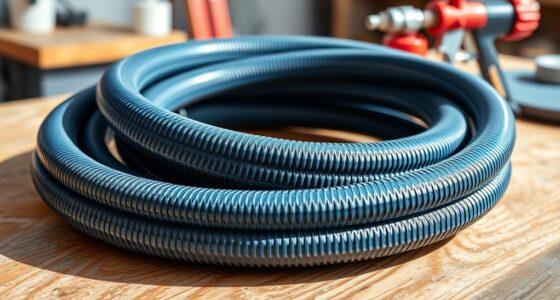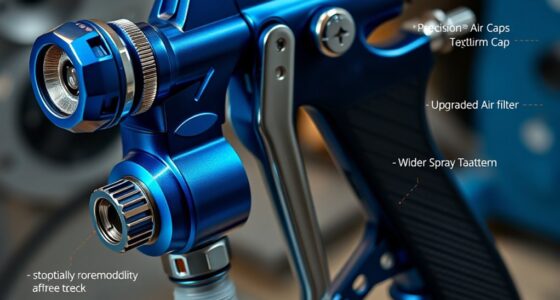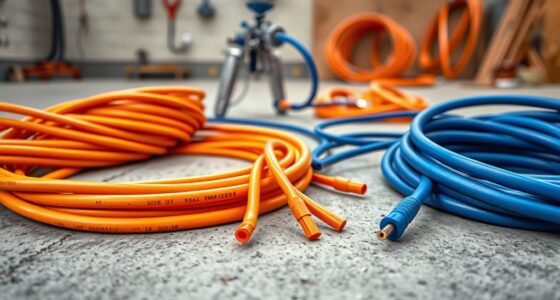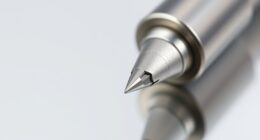When comparing plastic and metal spray guns, you’ll find that plastic ones are lightweight and resist corrosion, making them easier to handle and maintain, but they may not handle high pressure well and could degrade faster under tough conditions. Metal guns are more durable, offer consistent application, and are better suited for heavy-duty tasks, though they’re heavier and require different maintenance routines. Keep exploring to discover which material suits your specific spraying needs best.
Key Takeaways
- Metal spray guns offer greater durability and withstand tougher conditions better than plastic guns.
- Plastic spray guns are lightweight, reducing user fatigue during extended use, while metal guns are heavier but more stable.
- Metal guns provide more consistent spray patterns and superior performance under high-pressure applications.
- Plastic guns resist corrosion, requiring less maintenance, but may degrade in harsh environments over time.
- Metal spray guns typically have a longer lifespan due to their robust construction and material strength.

When choosing between plastic and metal spray guns, durability and performance are key factors to consider. Plastic spray guns are lightweight and resistant to corrosion, making them easier to handle for extended periods. However, they may not withstand high-pressure applications as well as their metal counterparts. Metal spray guns are generally more robust and capable of enduring tougher conditions, which can lead to longer service life. Additionally, the material of the spray gun can influence the quality of the spray pattern and overall application consistency. Proper maintenance and understanding of the material properties can significantly extend the lifespan of your equipment and ensure optimal performance.
Frequently Asked Questions
Are Plastic Spray Guns More Cost-Effective Than Metal Ones?
Plastic spray guns are generally more cost-effective than metal ones, offering significant cost savings upfront. Their lower price tag makes them ideal for DIY projects or occasional use. Plus, the material flexibility of plastics allows for lightweight designs that are easier to handle. However, keep in mind that while plastic guns save money initially, they may not last as long, affecting long-term value.
How Does Weight Affect User Fatigue During Prolonged Use?
Weight plays a vital role in user fatigue during prolonged use. Heavier spray guns can cause discomfort and strain, making your work more tiring over time. An ergonomic design helps distribute weight better, reducing fatigue and increasing control. Lighter guns are generally easier to handle, especially for extended periods. Choosing a spray gun with an ergonomic design not only minimizes fatigue but also guarantees you can work more efficiently and comfortably.
Can Plastic Spray Guns Withstand High-Pressure Applications?
Did you know that some plastic spray guns can handle pressures up to 3000 PSI? While they often have good pressure tolerance, their material flexibility is limited compared to metal guns. Plastic spray guns are suitable for light to medium applications but may crack or deform under high-pressure conditions. If you need durability at high pressure, a metal spray gun is typically more reliable, providing stronger, long-lasting performance.
What Are the Environmental Impacts of Plastic Versus Metal Spray Guns?
You might wonder about the environmental impacts of plastic versus metal spray guns. Plastic models often face recycling challenges due to complex materials and limited recyclability, which can lead to waste issues. Additionally, plastic’s lower biodegradability contributes to long-lasting pollution. Metal spray guns tend to be more recyclable and biodegradable over time, making them a more eco-friendly choice. Choosing metal helps reduce environmental harm linked to plastic’s recycling and biodegradability issues.
Are There Specific Cleaning or Maintenance Tips Unique to Each Material?
You might think cleaning and maintenance are straightforward, but each material demands a secret approach. For plastic spray guns, use gentle brushes and avoid harsh chemicals to prevent damage. Metal guns, on the other hand, need thorough lubrication and rust prevention routines. Mastering these cleaning tips and maintenance routines guarantees your spray gun stays in top shape longer, revealing the true power behind your work. Don’t overlook these details—they make all the difference.
Conclusion
When choosing between plastic and metal spray guns, remember that each has its strengths. Plastic guns are lightweight and budget-friendly, but may not withstand heavy-duty use. Metal guns, on the other hand, offer superior durability and consistent performance, making them a better long-term investment. Don’t put all your eggs in one basket—consider your specific needs and usage frequency. Ultimately, investing in quality pays off, so don’t settle for less than what will stand the test of time.
Franz came aboard the Paint Sprayer Zone team with a background in both journalism and home renovation. His articulate writing style, combined with a passion for DIY projects, makes him an invaluable asset. Franz has a knack for breaking down technical jargon into easy-to-understand content, ensuring that even the most novice of readers can grasp the complexities of paint sprayers.










